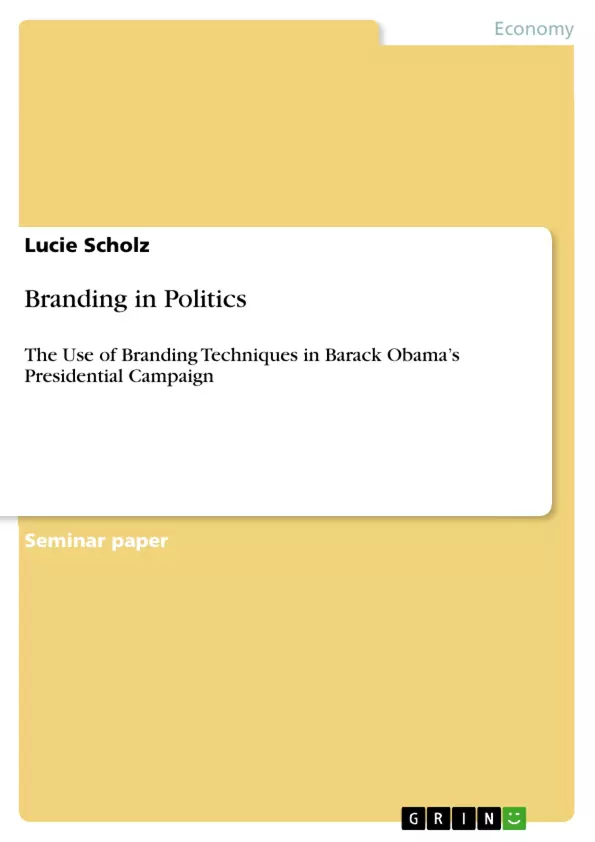Experts agree that Obama´s election victory is largely due to a unique and innovative election campaign which managed to convince voters. The huge efforts to raise funds to cover the costs and the extensive and comprehensive use of social media are considered the main innovations Obama introduced into his campaign. (Qualman, 2009, p. 64; Waters & Lester, 2010, p. 241; Harfoush, 2009, pp. VIII) They agree on the fact, that “Obama” can be considered a powerful brand: “Brand Obama is a real marketing phe-nomenon. He´s not only making politics cool, he´s outpacing Google and iPhone, the icon brands of this century”, states David Jones, CEO of one of the world´s biggest advertising agencies. (Euro RSCG Brand Momentum Study, 2008)
The target of this paper is to analyze from a marketing point of view the mechanisms which helped Barack Obama turn the game around – against initial odds. For this purpose, we will first of all deal with the theoretical bases of brand management. We will examine in detail the characteristic features of a brand in order to answer the question as to what extent the comparison of President Obama to a brand is justified. The subse-quent analysis of the functions of a brand has the purpose to explain in what way brands are capable of increasing a product's (or person’s) perceived value to the customer (or voter).
Inhaltsverzeichnis (Table of Contents)
- Introduction
- Barack Obama: From underdog to President
- Target and purpose
- Brand Management
- Brand definition
- Brand functions
- Politicians as brands
- The brand "Obama"
- Tangible elements of the brand "Obama"
- Name
- Claim
- Logo
- The packaging
- Intangible elements of the brand "Obama"
- The American Dream
- Change
- The role of social media in branding
- Tangible elements of the brand "Obama"
- Conclusion
Zielsetzung und Themenschwerpunkte (Objectives and Key Themes)
This paper aims to analyze the marketing techniques employed by Barack Obama during his presidential campaign, particularly those that contributed to his unexpected victory. By examining brand management concepts, the study aims to understand how branding strategies can be used to enhance a product's or a person's perceived value. It further seeks to explore the applicability of these strategies to politics, highlighting similarities and differences between branding in the commercial sector and political branding. The paper will focus on the core elements of the "Obama" brand, the channels utilized for its communication, and the role of social and digital media in the campaign.
- Branding strategies in politics
- The application of brand management concepts to individuals, particularly politicians
- The branding of Barack Obama's presidential campaign
- The role of social media in political branding
- The perceived value of a brand in influencing voters' decisions
Zusammenfassung der Kapitel (Chapter Summaries)
The introductory chapter provides a brief overview of Barack Obama's journey from a relatively unknown candidate to the President of the United States. It highlights his early political experiences, his initial challenges in the presidential race, and the factors that contributed to his eventual victory. The chapter also outlines the paper's objectives and its focus on analyzing the branding strategies employed by Obama's campaign.
Chapter 2 delves into the theoretical foundations of brand management, exploring the definition and functions of a brand. This section aims to establish a framework for understanding how brands can influence customer perceptions and ultimately drive purchasing decisions.
Chapter 3 examines the application of brand management concepts to the realm of politics. It explores the similarities and differences between branding in the commercial sector and political branding, providing a foundation for understanding the strategic use of branding in political campaigns.
Chapter 4 delves into the core elements of the "Obama" brand, analyzing its tangible elements such as the campaign logo, slogans, and packaging, as well as its intangible elements, including the themes of hope, change, and the American Dream.
The subsequent chapter explores the communication channels employed by the "Obama" campaign, with a particular emphasis on the role of social and digital media. It analyzes how these platforms were utilized to disseminate the brand's message and engage with voters.
Schlüsselwörter (Keywords)
The main focus topics and keywords of this paper include: branding in politics, political branding, brand management, Barack Obama's presidential campaign, social media in politics, voter perception, and the American Dream.
- Quote paper
- Lucie Scholz (Author), 2011, Branding in Politics, Munich, GRIN Verlag, https://www.grin.com/document/187821



